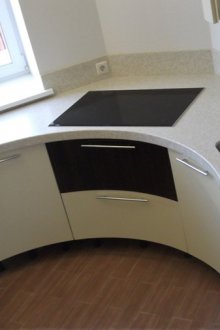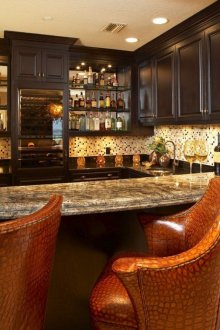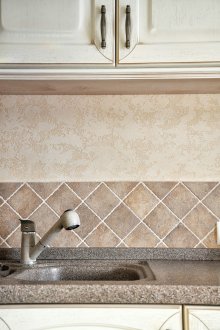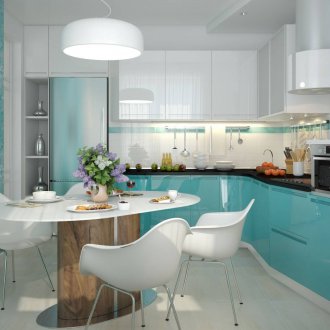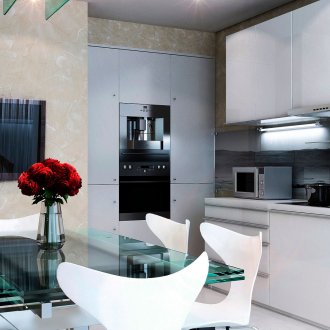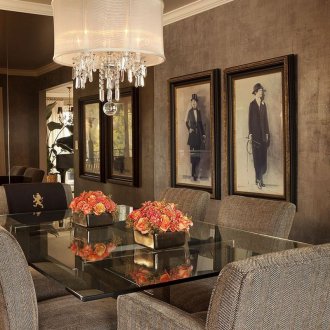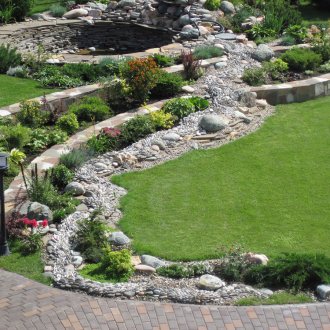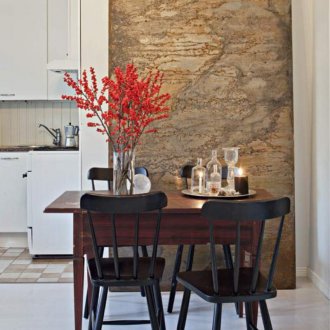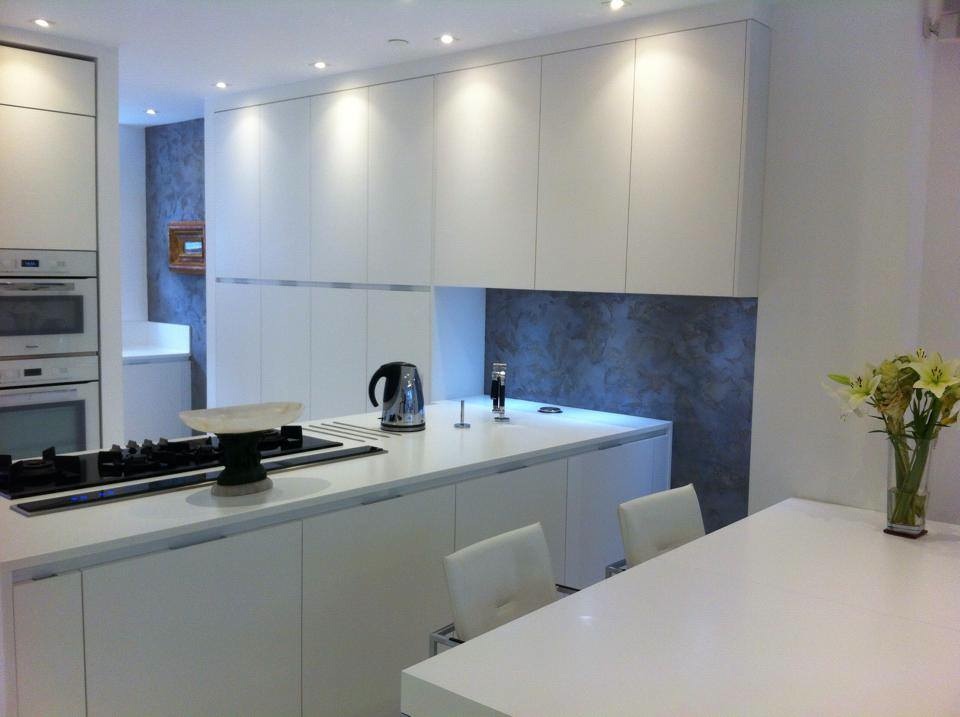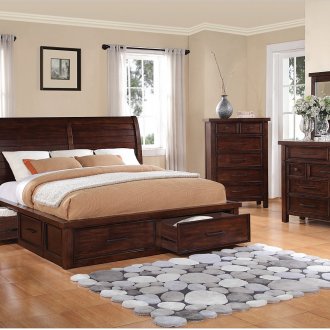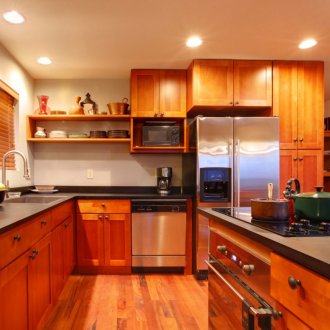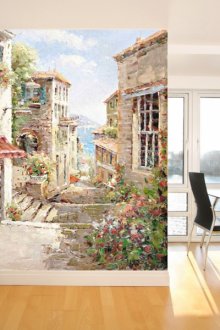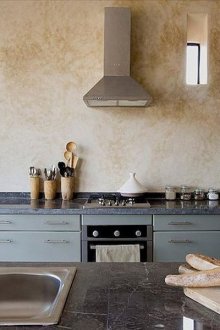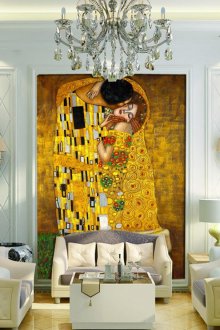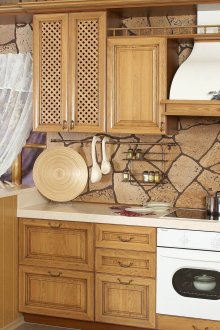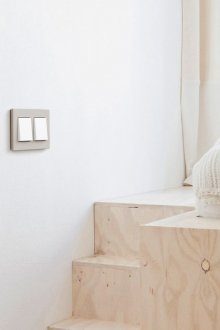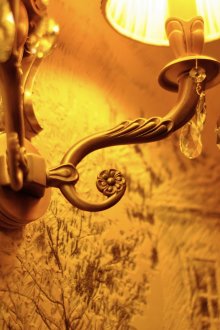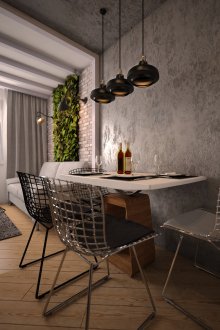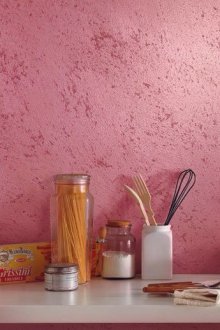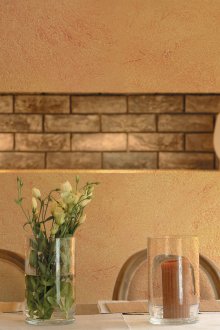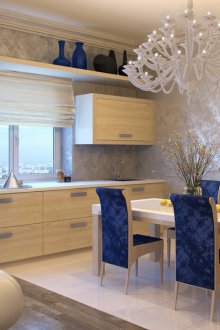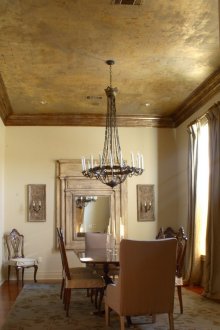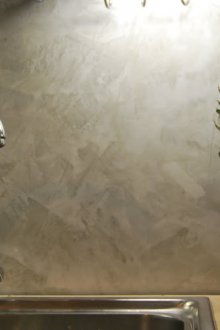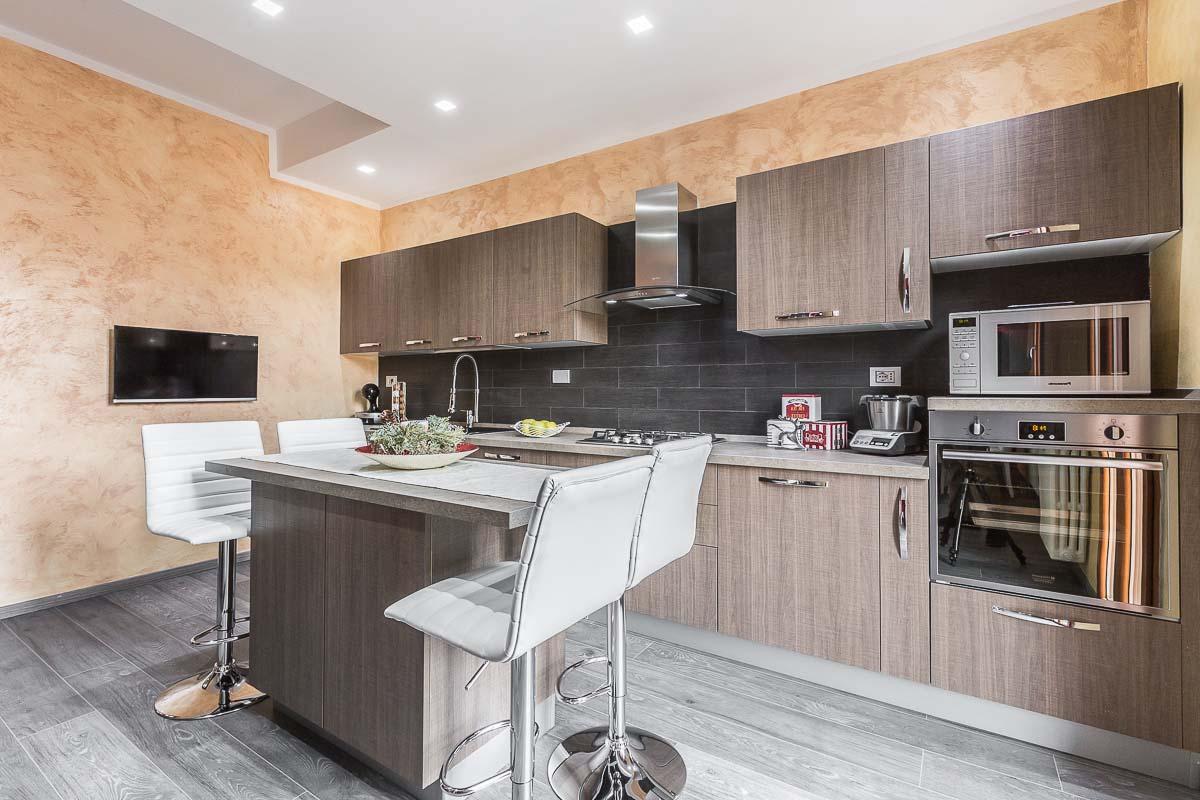Decorating the kitchen with decorative plaster - a stylish solution (25 photos)
Content
The kitchen can rightfully be called the heart of the house: it is nice to gather as a family or to meet with friends. This room should be stylish and beautiful and at the same time practical and functional. The materials used to decorate the kitchen are subject to fairly high requirements: they must be resistant to temperature and humidity changes, distinguished by durability and simple maintenance. Decorative plaster in the kitchen is a modern finishing method that perfectly meets all of the listed requirements.
Types and features of the material
Unlike the usual building mixture, which is traditionally used for leveling walls, decorative plaster is a special homogeneous mixture for finishing work. It may include granite grains, marble chips, plant fibers, algae, sand and other filler materials. The texture and pattern of the future coating will depend on the particles that make up such plaster.
For the original wall decoration, manufacturers offer a huge selection of decorative plasters based on natural and artificial fillers. Let us consider in more detail each of them:
- Mineral Dry cement-lime mixture, in which marble or granite chips were added. Kitchen walls with this finish are resistant to moisture, look stylish and luxurious.
- Silicone Synthetic resins are added to the mixture, due to which the composition is plastic and easy to apply, has excellent adhesion. Differs in resistance to ultra-violet, mechanical influences. Experts evaluate it as the highest quality, which justifies the high cost of the material.
- Synthetic. Contains acrylic resins, water glass, nylon fiber, styrene.
- Acrylic It is considered universal. It is made on the basis of liquid glass. The coating is vapor permeable, quite resistant to mechanical damage. When using this mixture, preliminary alignment of the walls in the kitchen is not required. It dries very quickly. For the price - this is the best option.
In addition, classify the plaster and the appearance. It happens:
- Structural. Due to the presence of fillers of various sizes in the composition, the masters create a spectacular pattern on the walls: grooves, stains, streaks. Sometimes, in order to give the kitchen walls the effect of scuffing and noble aging, colorless granules are included in the mixture. Bursting with a spatula, these granules leave frayed traces. Structural plaster is used for fashionable kitchen decoration using craquelure technique. Drying, the composition forms spectacular cracks, which subsequently tint and stand out. In general, the impression of an old interior.
- Embossed. This decorative plaster in the kitchen is used to create volumetric patterns. The most common types are “bark beetle”, “lamb”, with imitation of water drops on the surface, with imitation of stone, jammed paper, wood and leather.
- Venetian. It is used to simulate expensive finishing materials: travertine, marble, mahogany, precious metals. It looks expensive and natural.
- Sgraffito. The coating resembles an application.Using stencils and templates, the masters decorate the walls with patterns, drawings, inscriptions, etc. And even if you want to have clouds on the ceiling of your kitchen, or a family coat of arms decorate the walls, this technique will help bring your ideas to life.
- Flock. Literally "flock" in translation from English means a feather, a scrap. This interesting technique with spraying onto a plastered surface textile, cellulose fibers and villi can be called a kind of know-how of manufacturers of finishing mixtures.
- Smooth plaster. With this method of finishing, the mixture is applied in 2 layers, achieving a flat and smooth surface. This design can be called the best and most common for small kitchens or studio apartments. At the same time, it can be considered decorative with a big stretch.
There is also a classification for the size of the filler. Mixtures are coarse-grained and fine-grained. With the help of coarse-grained walls, an expressive texture is given, this finish is less prone to risks of mechanical damage. Fine-grained mixtures can be used for finishing the kitchen, with the exception of working areas, since the coating is easily damaged.
Decorating the kitchen with decorative plaster is suitable for walls, ceilings, as well as arches, ledges and niches. With a competent combination of texture, color and type of plaster, you will get not only a stylish design of the room, but also save square meters and arrange a cozy home.
Benefits and Performance
Modern finishing mixes are safe, meet the requirements of environmental friendliness and hygiene, non-toxic. Thanks to antiseptic additives, mold and fungus will not form on the surface. Walls with decorative plaster are characterized by good sound insulation and resistance to fire. Among the advantages of this type of finish can be called a number of characteristics:
- wide selection of textures, color schemes;
- seamlessness due to which irregularities and defects become invisible. The absence of joints and seams greatly facilitates care, helps to keep the coating in its original form;
- maintainability. If the finish is damaged, this area can be restored quickly enough;
- wear resistance, strength and durability;
- the ability to create a unique kitchen design. The use of picturesque plaster mixes allows you to simulate and create original coatings: from noble stone to luxurious silk surfaces.
Experienced builders call decorative plaster a universal material suitable for almost any surface: drywall, concrete, brick and wood. Of course, when working with mixtures, a certain skill and experience is required, but if desired, this technology can be quickly mastered. The finished mixture is offered in convenient containers, the material is used economically.
disadvantages
According to those who used decorative plaster in the interior of the kitchen, the coating corresponds to the declared operational characteristics, but still has some drawbacks, the main one being the high cost of the material, and corrosion was observed when coating metal surfaces. In addition, plaster can not be used for cladding structures insulated with mineral wool. It was also noted that mainly professional craftsmen were involved in the finishing work, thereby increasing the cost of repairing the kitchen.
Features of working with material
Work with decorative finishing mixes is divided into several stages. Surface preparation is preliminarily carried out - leveling, priming. Then there is a direct application of the mixture in several layers. Each coat must be well dry before applying the next. Polishing or glazing is performed at the final stage.To increase strength and performance, the surface is usually coated with wax or special varnish. This gives the finish a glossy sheen.
On the walls, decorative plasters are not painted. The dye is added to the mixture, do this before applying each layer.
To obtain original color solutions, the blur method is used. If you need to get any pattern, for this purpose it is recommended to use plastic mixtures. The texture is not formed immediately, but only 30 minutes after application.
Masters to obtain embossed surfaces work with special tools, these are dies, grinding sponges, textured and gear rollers. For applying expensive mixtures, a horn or coral sponge is used. Home craftsmen use hard kitchen sponges for this purpose. To remove small irregularities, sanding or grouting with a fine abrasive mesh is performed after the finish has completely dried.
What to consider when choosing a material?
If you decide to apply decorative plaster yourself, the following recommendations will help you when choosing a material. It is advisable not to use cheap mixtures, but too expensive ones require professional skills. It is advisable for beginners to choose acrylic plasters that are easiest to work with. Consider the features of the interior of the kitchen and the type of plaster.
